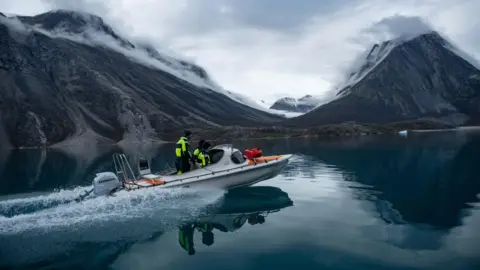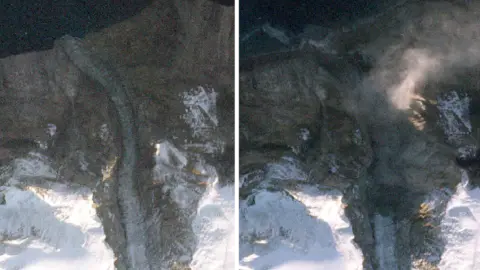
 Jeff Kerby
Jeff KerbyA massive landslide in a Greenland fjord triggered a wave that “shook the Earth” for nine days.
The seismic signal last September was picked up by sensors all over the world, leading scientists to investigate where it had come from.
The landslide – a mountainside of rock that collapsed and carried glacial ice with it – triggered a 200m wave.
That wave was then “trapped” in the narrow fjord – moving back and forth for nine days, generating the vibrations.
Landslides like this, scientists say, are happening more frequently with climate change – as the glaciers that support Greenland’s mountains melt.
The results of the investigation into this event, which are published in the journal Science, are the result of a detective mission involving an international team of scientists and the Danish Navy.
“When colleagues first spotted this signal last year, it looked nothing like an earthquake. We called it an ‘unidentified seismic object’,” recalled Dr Stephen Hicks from UCL, one of the scientists involved.
“It kept appearing – every 90 seconds for nine days.”
A group of curious scientists started to discuss the baffling signal on an online chat platform.
“At the same time, colleagues from Denmark, who do a lot of fieldwork in Greenland, received reports of a tsunami that happened in a remote fjord,” explained Dr Hicks. “So then we joined forces.”
The team used the seismic data to pin down the location of the signal’s source to Dickson Fjord in East Greenland. They then gathered other clues, including satellite imagery and photographs of the fjord that were taken by the Danish Navy just before the signal appeared.
A satellite image showed a cloud of dust in a gully in the fjord. Comparing photographs before and after the event revealed that a mountain had collapsed and swept part of a glacier into the water.
The researchers eventually worked out that 25 million cubic metres of rock – a volume equivalent of 25 Empire State Buildings – slammed into the water, causing a 200m-high “mega-tsunami”.
In the “after” photographs of the location, a mark is visible on the glacier – left by the sediment that the giant wave hurled upwards.
 Wieter Boone
Wieter Boone‘Wave couldn’t dissipate its energy’
Tsunamis, usually caused by underground earthquakes, dissipate within hours in the open ocean. But this wave was trapped.
“This landslide happened about 200km inland from the open ocean,” Dr Hicks explained. “And these fjord systems are really complex, so the wave couldn’t dissipate its energy.”
The team created a model that showed how, instead of dissipating, it sloshed back and forth for nine days.
“We’ve never seen such a large scale movement of water over such a long period,” said Dr Hicks.
Scientists say the landslide was caused by rising temperatures in Greenland, which have melted the glacier at the base of the mountain.
“That glacier was supporting this mountain, and it got so thin that it just stopped holding it up,” said Dr Hicks. “It shows how climate change is now impacting these areas.”
 Copernicus Sentinel Data, 2023/ESA
Copernicus Sentinel Data, 2023/ESAWhile this event was in a a remote area, these fjords are visited by some Arctic cruise ships. Fortunately none were in the area where this landslide occurred. But the lead researcher, Dr Kristian Svennevig from the National Geological Surveys for Denmark and Greenland (GEUS), said this was an increasingly common phenomenon in the Arctic.
“We are witnessing a rise in giant, tsunami-causing landslides, particularly in Greenland,” he told BBC News.
“While the Dickson Fjord event alone doesn’t confirm this trend, its unprecedented scale underscores the need to carry out more research.”
The event at Dickson Fjord, Dr Hicks added, “is the perhaps first time a climate change event has impacted the crust beneath our feet all the world over.”






